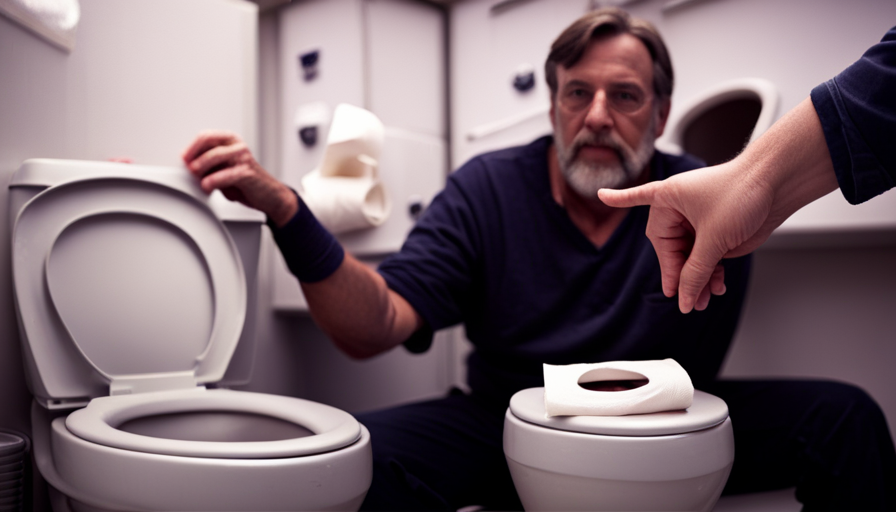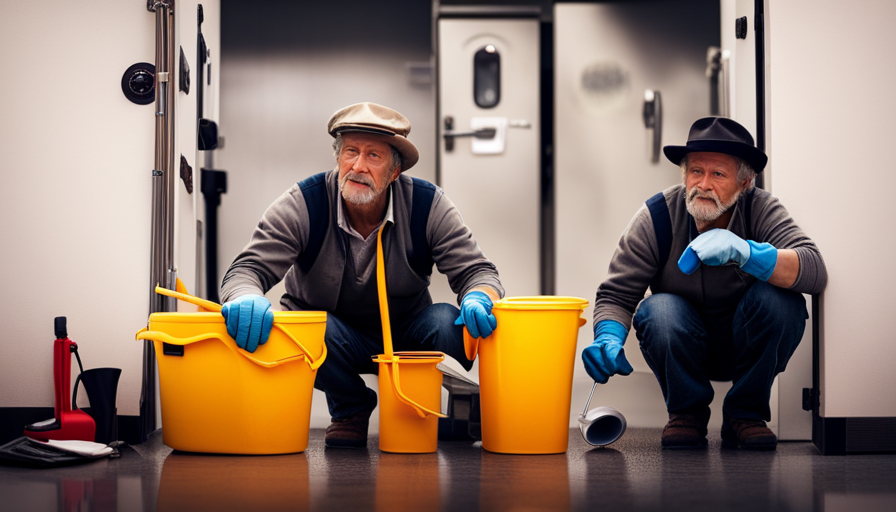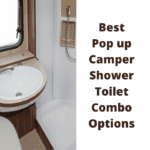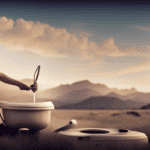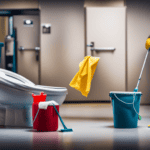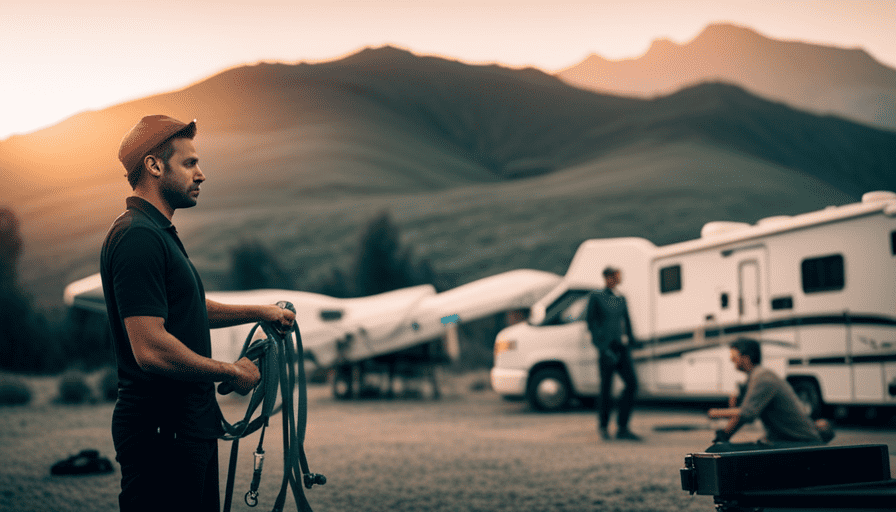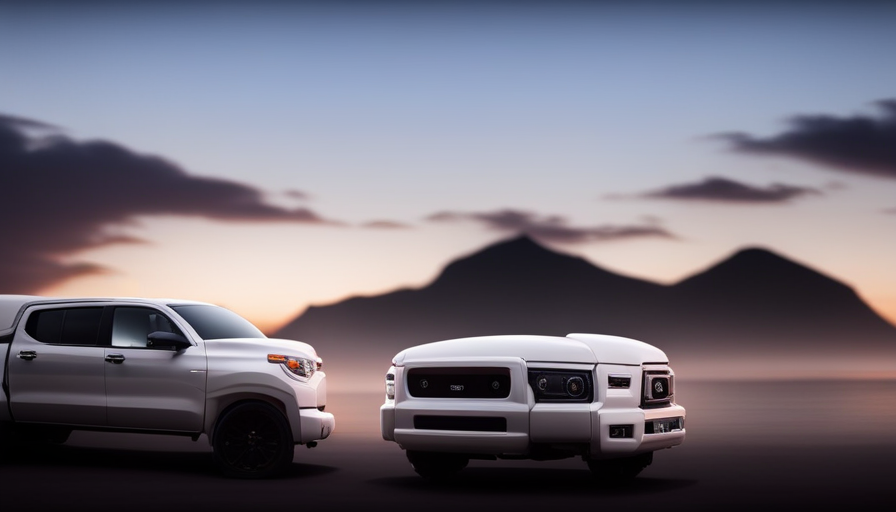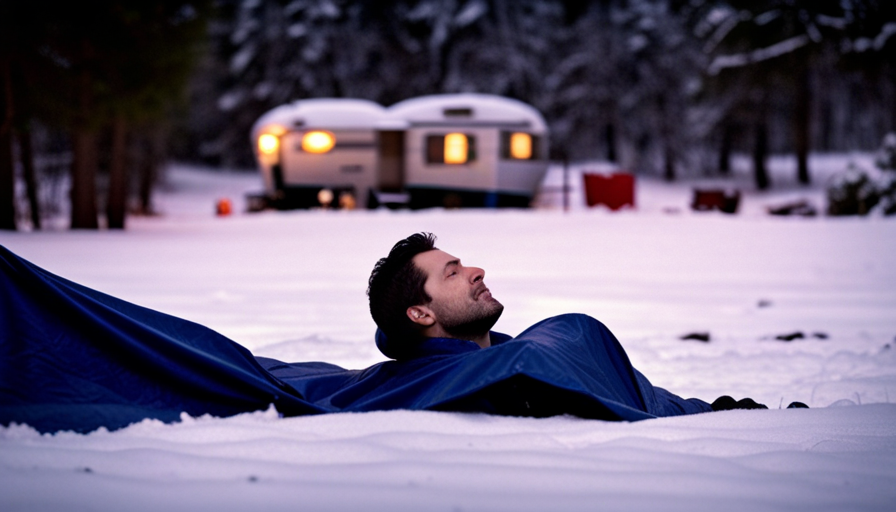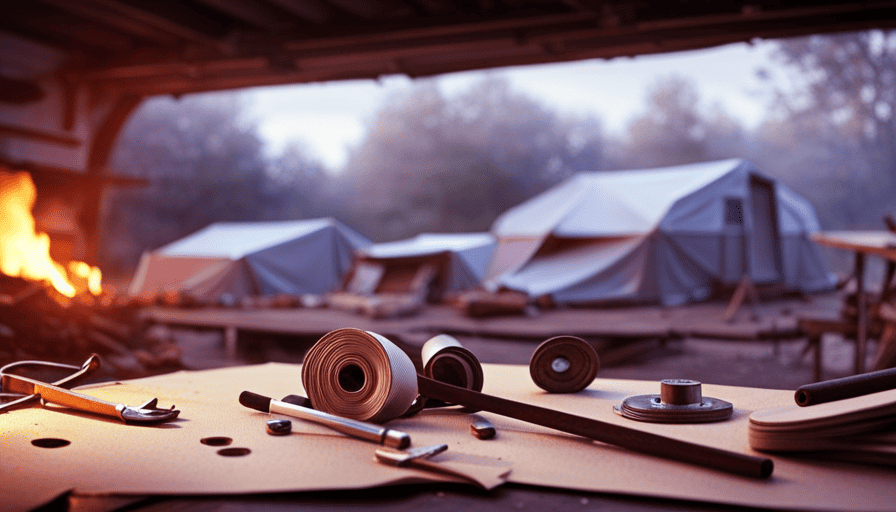Picture yourself exploring the expansive wilderness, uncovering hidden trails, and fully embracing the beauty of the great outdoors. When embarking on your camping adventure, it is crucial to have the necessary knowledge and skills, including knowing how to properly use a camper toilet. Whether you are a seasoned camper or new to the RV lifestyle, understanding the fundamentals of this vital system is key.
In this article, we will guide you through the process of using a camper toilet with ease and confidence. From pre-use preparation to proper waste disposal, we’ll cover all the bases. So, let’s dive in and discover the secrets to a clean and hassle-free camper toilet experience.
Get ready to make the most of your time in the great outdoors, without any worries about the toilet situation.
Key Takeaways
- Proper handwashing and hygiene practices before and after using the toilet
- Importance of using biodegradable and septic-safe toilet paper
- Importance of following campground rules and regulations
- Regular cleaning and maintenance of camper toilets is crucial
Get Familiar with the Camper Toilet System
Now that you’re ready to dive into the world of camper toilets, let’s get familiar with how this amazing system works! One of the first things you need to know is how to prevent clogs in your camper toilet. It’s essential to remember that only waste and toilet paper should be flushed down the toilet.
Avoid flushing anything else, like feminine hygiene products or baby wipes, as they can cause clogs in the system. Additionally, using the right toilet chemicals is crucial to maintaining a smooth-running camper toilet. These chemicals help break down waste and control odors. Look for chemicals that are specifically designed for camper toilets and follow the instructions on the packaging for best results.
Now, let’s move on to the next section about proper pre-use preparation. This step is essential to ensure a clean and hygienic experience when using your camper toilet.
Proper Pre-Use Preparation
First, make sure you’ve properly cleaned and prepared the portable restroom before getting ready to go. This is an essential step to ensure a hygienic and comfortable experience. Here’s a pre-use checklist to follow:
-
Check the water supply: Make sure the water tank is filled with fresh water. This will be used for flushing and cleaning purposes. If needed, fill it up before use.
-
Stock up on cleaning supplies: Keep a supply of biodegradable toilet paper, disinfectant wipes, and hand sanitizer handy. These are essential for maintaining cleanliness and preventing the spread of germs.
-
Empty the waste tank: Before using the camper toilet, make sure the waste tank is empty. This will prevent any unpleasant surprises during use.
By following this pre-use checklist, you can ensure that your camper toilet is ready for use and clean.
Once you’ve completed these steps, you can now move on to the next section about following proper hygiene practices. It’s important to practice good hygiene to keep yourself and others safe and healthy.
Follow Proper Hygiene Practices
Make sure you’ve got the essential supplies and take the necessary steps to keep yourself and others safe and healthy while using the portable restroom. When it comes to hygiene practices, there are a few key things to keep in mind.
First, always wash your hands thoroughly with soap and water before and after using the camper toilet. This helps prevent the spread of germs and keeps you feeling fresh. Additionally, using hand sanitizer can be a good alternative if water isn’t readily available.
Toilet maintenance is also crucial for a clean and comfortable experience. Remember to regularly clean the toilet seat and surrounding area with disinfectant wipes or spray. This helps reduce the risk of bacteria buildup and ensures a sanitary environment. It’s also important to dispose of any waste properly. Use the designated waste disposal bags provided and seal them tightly to prevent any leaks or odors.
By following these hygiene practices and maintaining the cleanliness of the camper toilet, you can ensure a pleasant and safe experience for everyone. Now, let’s move on to the next section and learn about how to flush and dispose of waste properly.
Know How to Flush and Dispose of Waste
Ensure a pleasant and odor-free experience by properly flushing and disposing of waste in the portable restroom. When it comes to flushing techniques, it’s important to use the appropriate amount of water to effectively flush away waste. Most camper toilets have a foot pedal or lever that activates the flushing mechanism. Simply press down on the pedal or move the lever to release the water and flush the waste down the toilet bowl. Make sure to hold the pedal or lever down for a few seconds to ensure a thorough flush.
After flushing, it’s crucial to dispose of waste properly. Many camper toilets have a built-in waste holding tank that needs to be emptied regularly. To do this, locate the waste tank and follow the manufacturer’s instructions on how to remove and empty it. Remember to wear gloves and take precautions to avoid any contact with the waste.
Now that you understand the flushing techniques and waste disposal methods, let’s move on to how to use toilet paper and other products properly.
Use Toilet Paper and Other Products Properly
To maximize your comfort and cleanliness, remember to be mindful of how you handle toilet paper and other essential products in the portable restroom. Proper wiping technique is crucial to maintaining hygiene. When using toilet paper, it’s important to wipe from front to back to prevent the spread of bacteria. Be gentle and thorough to ensure cleanliness.
Choosing the right toilet paper is also essential for a comfortable experience. Opt for biodegradable and septic-safe options to prevent clogging and damage to the camper toilet system.
In addition to toilet paper, there are other products that can enhance your experience. Wet wipes or baby wipes are convenient for a more thorough clean. However, it’s important to choose wipes that are specifically labeled as safe for flushing, as some can cause blockages in the plumbing system. Hand sanitizer or antibacterial wipes are also useful to maintain cleanliness after using the restroom.
To maintain odor control, it’s important to properly dispose of used toilet paper and wipes. Make sure to follow the instructions provided by the manufacturer or campground for disposing of waste.
By using the proper techniques and products, you can ensure a comfortable and odor-free environment in your camper toilet.
Maintain Odor Control
Combat unpleasant smells by incorporating effective odor control methods into our portable restroom routine. Maintaining cleanliness is key to preventing odors from becoming overpowering.
One important step is to regularly clean the toilet bowl with a mild disinfectant. This will not only eliminate odors but also prevent the buildup of bacteria and germs.
Additionally, using odor control products such as deodorizing tablets or sprays can help neutralize any unpleasant smells. These products are specifically designed to mask odors and leave a fresh scent behind.
In order to prevent clogs, it’s essential to use the camper toilet properly. Avoid flushing anything other than toilet paper down the toilet, as this can lead to blockages in the plumbing system.
It’s also important to use an appropriate amount of water when flushing. Too little water can result in incomplete flushing, while too much water can cause the toilet to overflow.
Maintaining odor control and preventing clogs are essential aspects of using a camper toilet. By following these tips, you can ensure a clean and pleasant restroom experience during your camping trip.
Now, let’s move on to discussing how to follow campground rules and regulations for using the camper toilet.
Follow Campground Rules and Regulations
Comply with campground rules and regulations to ensure a harmonious and respectful experience for all campers. Campground etiquette is an essential aspect of using a camper toilet, as it helps maintain a clean and pleasant environment for everyone.
Here are three reasons why it’s crucial to read and follow the campground rules:
-
Respect for Others: By adhering to the rules, you show consideration for fellow campers. Noise restrictions, designated quiet hours, and proper disposal of waste are just a few examples. Respecting others’ peace and privacy will enhance the overall camping experience for everyone.
-
Preservation of Nature: Campgrounds typically have rules in place to protect the surrounding environment. This may include restrictions on campfires, littering, and the use of biodegradable products. By following these rules, you contribute to the preservation of nature and leave a minimal ecological footprint.
-
Safety and Security: Campground rules often address safety concerns such as speed limits, fire safety, and wildlife encounters. Familiarizing yourself with these regulations ensures the well-being of yourself and others.
By understanding and respecting the campground rules, you can fully enjoy your camping experience.
Now, let’s delve into the next important aspect: practicing proper waste management.
Practice Proper Waste Management
When it comes to waste management at campgrounds, it’s important that you remember to properly dispose of your trash and recyclables, as it is estimated that each person generates an average of 4.4 pounds of waste per day while camping. Proper waste disposal not only ensures a clean and pleasant environment for everyone, but it also minimizes the environmental impact.
Start by separating your trash from recyclables. Most campgrounds provide designated bins for each type of waste. Make sure to rinse out any containers that held food or liquids before placing them in the recycling bin. This helps prevent contamination and ensures that the recyclables can be properly processed.
When disposing of non-recyclable waste, such as food scraps or packaging, use sturdy trash bags to prevent any leakage or littering. Double-check campground rules to see if there are any specific guidelines for waste disposal, such as whether you need to bag your trash or if there are certain hours for collections.
Remember, waste management is an ongoing responsibility. Regularly check your campsite for any litter or trash that may have blown away. Dispose of it properly to maintain the cleanliness of the campground. Additionally, if you notice any overflowing or damaged bins, report it to the campground staff so that they can address the issue promptly.
By practicing proper waste management, you can contribute to a clean and sustainable camping experience.
Now let’s move on to the next section about regular cleaning and maintenance.
Regular Cleaning and Maintenance
Now that we’ve discussed the importance of practicing proper waste management in your camper toilet, let’s move on to the next crucial aspect of maintaining a clean and functional toilet: regular cleaning and maintenance.
Keeping your camper toilet clean is essential not only for hygiene purposes but also to prevent any unwanted odors or blockages.
Toilet maintenance in a camper involves a few key cleaning techniques. First, it’s important to regularly clean the toilet bowl using a toilet brush and a mild cleaner specifically designed for RV toilets. Scrub the bowl thoroughly, paying attention to the rim and under the seat. Additionally, make sure to clean the external surfaces of the toilet, including the seat and handle.
In addition to regular cleaning, it’s also essential to perform routine maintenance tasks. This includes checking for and repairing any leaks or cracks in the toilet’s plumbing system. It’s also advisable to regularly inspect and clean the sewage tank to prevent any buildup or clogging.
By following these toilet maintenance and cleaning techniques, you can ensure that your camper toilet remains in optimal condition for your travels.
In the next section, we’ll discuss some valuable tips for troubleshooting common problems that may arise with your camper toilet.
Tips for Troubleshooting Common Problems
Have you ever encountered common issues with your RV toilet? Let’s dive into some helpful tips for troubleshooting and resolving those problems.
-
Toilet Leaks:
-
Check the water supply connections: Ensure that the water supply valve is fully open and that there aren’t any leaks or loose connections.
-
Inspect the toilet seal: The toilet seal may need to be replaced if you notice water pooling around the base of the toilet.
-
Check the flush valve: A faulty flush valve can cause leaks. Inspect it for any signs of damage or debris that may be preventing a proper seal.
-
Toilet Clogs:
-
Use a plunger: A plunger can often unclog minor toilet blockages. Make sure to use a plunger specifically designed for RV toilets.
-
Use an enzyme-based cleaner: Enzyme-based cleaners can help break down waste and eliminate clogs. Follow the instructions on the product for best results.
-
Avoid flushing non-biodegradable items: To prevent clogs, only flush toilet paper and waste. Avoid flushing items like wet wipes, feminine hygiene products, or paper towels.
By following these troubleshooting tips, you can effectively address common issues with your camper toilet. Remember to regularly clean and maintain your toilet to prevent future problems.
Frequently Asked Questions
What type of toilet paper should I use in a camper toilet?
When it comes to using a camper toilet, the type of toilet paper you should use is crucial. Many people assume that regular toilet paper will work just fine, but it can quickly clog up the system and cause costly damage. That’s why it’s essential to use RV toilet paper specifically designed for camper toilets.
While there are alternative options available, such as biodegradable toilet paper, it’s best to stick with RV toilet paper to ensure a smooth and trouble-free experience.
How often should I empty the waste tank in a camper toilet?
To maintain a camper toilet, it’s important to regularly empty the waste tank. Best practices suggest emptying the tank when it’s about two-thirds full, or every 3-5 days, depending on usage. This prevents overflow and unpleasant odors. Additionally, it’s recommended to clean the waste tank thoroughly after each use. This ensures proper hygiene and prolongs the lifespan of the camper toilet. Remember to follow the manufacturer’s instructions for specific cleaning and maintenance guidelines.
Can I use regular household cleaning products to clean the camper toilet?
Using regular household cleaning products on a camper toilet can be harmful to the system. It’s important to know what products are safe to use. Harsh chemicals can damage the seals and valves, leading to leaks and malfunctions. Instead, opt for RV-specific cleaners or mild, non-abrasive alternatives. These products are designed to clean without causing damage.
Regular maintenance and proper cleaning practices will help keep your camper toilet in good working condition.
Are there any specific rules or regulations regarding camper toilets at campgrounds?
When it comes to camper toilets at campgrounds, there are specific rules and regulations in place. These regulations mainly pertain to waste disposal methods.
Campgrounds typically require campers to use designated dump stations for emptying their waste tanks. It is important to follow these regulations to ensure proper sanitation and environmental protection.
Familiarize yourself with the campground’s guidelines and always dispose of waste in the appropriate manner to maintain a clean and safe camping environment.
What are some common problems that can occur with camper toilets and how can I troubleshoot them?
When it comes to camper toilets, troubleshooting can be a common issue. Some problems you may encounter include clogs, leaks, and odors.
To fix a clog, try using a plunger or a chemical drain cleaner.
For leaks, check the seals and connections for any damage or loose fittings.
To combat odors, regularly clean the toilet and use RV-friendly deodorizers.
Proper maintenance practices, such as regular cleaning and inspection, can help prevent these issues from occurring in the first place.
Are There Any Specific Toilet Maintenance Tips for Campers?
When it comes to using hot water heater camper, it’s important to follow specific toilet maintenance tips while camping. Make sure to use RV-friendly toilet paper to avoid clogging. Additionally, regularly inspect and clean the toilet components to prevent any issues with the hot water heater camper system.
Conclusion
So there you have it, folks! Using a camper toilet may seem like a daunting task, but with a little know-how and practice, it can become second nature.
From getting familiar with the system to following proper hygiene practices, we’ve covered it all.
And remember, proper waste management is key! So next time you find yourself on a camping trip, don’t be afraid to embrace the camper toilet experience. It’s a journey like no other, filled with adventure, surprises, and maybe even a few clogged pipes along the way.
Happy camping!

